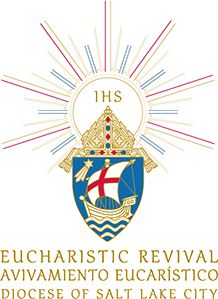4-Minute Reflections on the Mass – Introduction
(Editor’s note: This is the first in a series of reflections on the importance of the Eucharist and what it means to be a Eucharistic people. These reflections are part of the Diocese of Salt Lake City’s participation in the National Eucharistic Revival, which began June 19 and will end in July of 2024 with the National Eucharistic Congress in Indianapolis. These reflections are designed to be read aloud at Mass by a priest, deacon or experienced minister following the Prayer after Communion. They will appear in print in this newspaper and on the diocese website, www.dioslc.org. The series of reflections will continue through June of 2023 in preparation for the July 9, 2023 Diocesan Eucharistic Rally at the Mountain America Expo Center in Sandy.)
The Eucharist is the Source and Summit of the Christian Life. The reason why we gather together every Sunday is not just for the community or for the spiritual lessons we might learn in the homilies. Those things are good and necessary, but the reason why we are able to gather in the first place is the Eucharist. The Mass is built around and builds up to the moment when we all participate in the Body and Blood of Christ. You may be hearing this for the first time, or maybe you’ve heard this sentiment so frequently that it doesn’t mean much to you anymore. But we must realize – at the heart of the Catholic Church is the Eucharist, because it unites us to God by allowing us to participate in his sacrifice together through the Mass.
We can only truly understand the gift of the Eucharist if we can understand why we gather for Mass. While we celebrate the Eucharistic Revival within the United States, the Diocese of Salt Lake City will be presenting a series of brief reflections on the Mass. These 4-minute reflections are meant to be a mini “class on the Mass.”
We will walk through the entire Mass over this series of reflections, and we will begin to notice that every single detail of the Mass, even those we may not be familiar with, point to and find their full meaning in the Eucharist. If you have ever wondered to yourself, “Why do we do this during the Mass? What’s the purpose of having that during the Mass? Why can’t we do this for the Mass?” then hopefully these reflections will answer all those questions, all while explaining that every part ultimately leads us to understand and appreciate the Eucharist. We will discover a harmony between the components of Mass and the presence of Christ throughout the history of our faith.
St. Augustine once addressed God by calling him “Beauty ever ancient, ever new.” This description is equally appropriate when describing the Mass. The Mass itself is not new; Christ himself instituted the Mass at the Last Supper and handed it down to us, but we can experience his words and actions at the Last Supper now in the present moment. Because the Mass comes to us directly from Christ, each part of it indicates how we can find him, love him, know him, and share him to the world.
The Eucharist is the Real Presence of Jesus Christ among us and within us; everything about the Mass revolves around it, and Christ gradually reveals his presence more clearly and more deeply to us throughout the Mass until the moment of consecration. We in turn become Christ to others when we receive him into our hearts and are called to “Go forth.”
Through these reflections, you’ll learn new things about the Mass. You’ll find that the Mass allows us to relive the entirety of Salvation History, from the sacrifice rituals of the Old Testament to the Wedding Feast of the Lamb in the book of Revelation.
If you’re new to Mass, you might have noticed that we use all of our five basic senses (sight, sound, touch, taste and smell) during the liturgy, which helps us to unite our souls to God through our bodies. This is because Mass is actively lived. Through our bodies and in the Mass, we adore God, we express our remorse for our sins, we thank him for all he has done, and we ask him to reveal himself to us. Eventually, our time together ultimately leads to the moment when he does reveal himself fully in the Eucharist. But the process, as we will come to learn through these reflections, is gradual and constant throughout the Mass.
© Copyright 2025 The Diocese of Salt Lake City. All rights reserved.


Stay Connected With Us